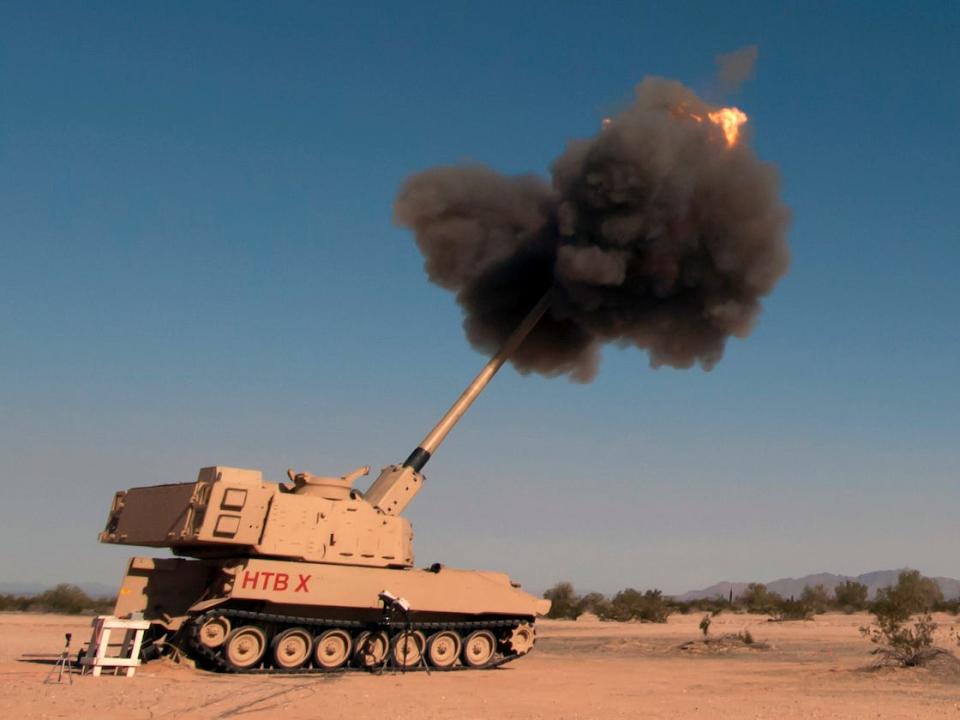As Ukraine and Russia burn through artillery shells, the US Army is looking for new highly precise rounds to fire from its extra-long-range cannons
Artillery has been one of the most heavily used weapons by both Russia and Ukraine.
The intensity of its use has added urgency to the US military's efforts to update its artillery.
As part of that work, the US Army is investing in precision shells and long-range cannons.
The war in Ukraine has highlighted both the value of precision-guided artillery rounds and how such munitions can be foiled by jamming navigational technologies such as GPS.
But the US Army is moving forward with a plan to design a self-guided 155-mm shell that can home in on tanks and other targets, even when GPS signals are jammed and can be fired to ranges well beyond what current US artillery can reach.
The Army recently published a market-survey request to identify companies that can manufacture the Cannon-Delivered Area Effects Munitions, or C-DAEM. The project actually predates the war, with the Army seeking funding for it as far back as 2018.
The market survey describes C-DAEM as a munition designed to destroy tanks, infantry fighting vehicles, and self-propelled howitzers at extended ranges compared with current rounds. It can be fired from current 39-caliber howitzers — which means the gun tube is 39 times as long as it is wide — such as the M109A6 Paladin self-propelled howitzer and M777 155-mm towed guns.

Perhaps more important, C-DAEM "is desired to operate at the high-muzzle velocities required to achieve 70 km with developmental propellants out of the XM1299 Extended Range Cannon Artillery (ERCA) artillery weapon system," the Army said.
Long-range weapons, such as US-made HIMARS rockets with a 50-mile reach, have proven devastating in Ukraine. The US Army is pinning its hopes on the ERCA program to revitalize its long-neglected artillery by producing a new 155-mm, 58-caliber howitzer to keep pace with Chinese and Russian cannon and rockets with ranges of up to 45 miles. (The US Army's Paladin has a range of about 25 miles.)
The emergence of artillery as the dominant weapon in Ukraine — especially with long-range guided munitions — has only added urgency to the Army's plan to upgrade its big guns.
C-DAEM shells are expected to be autonomous, using on-board sensors to detect, identify, and home in on targets rather than relying on GPS signals, which can be jammed, or a human observer tasked with the difficult and dangerous task of painting the target with a laser designator.
If it works as designed, a C-DAEM round could be launched into a high-traffic area deep in enemy territory to hunt armor or be used closer to the front to support friendly troops.

A 2017 Army request for information required "the projectile and its payload to operate in GPS Denied/Degraded conditions and perform in high target location error (TLE) environments."
A 2018 Army notice specified the round should be able to reach ranges of roughly 14 miles to 81 miles on "a modern, high-intensity battlefield" and be "capable of defeating stationary and moving armored vehicles" that "may be poorly located (target location error of 50-2000 meters) or moving."
The round should be able to defeat an armored vehicle's mobility or ability to fire "across the full range of environmental conditions and in the presence of cyber, jamming, and obscurant countermeasures," the 2018 notice said.
D-CAEM addresses multiple issues.
One is the need to "engage moved or moving targets at extended ranges, and ultimately the ability to differentiate between friendly and hostile vehicles," Army managers said in 2019. Unguided artillery rounds can't do this except with a lucky shot, and even guided munitions such as the Excalibur 155-mm GPS-guided shell would be challenged to do so.

Another is devising guided munitions that can home in on targets even when GPS is jammed or disrupted. Russia, which has invested heavily in electronic warfare since the Soviet era, has had some success jamming Western-made guided munitions supplied to Ukraine, including HIMARS rockets and JDAM glide bombs.
C-DAEM also has political appeal. From the 1970s to the 1990s, one of the Army's most potent weapons was the Dual-Purpose Improved Conventional Munition, or DPICM, a howitzer shell that showered the target zone with 88 antipersonnel and antitank bomblets.
But a failure rate of up to 20% meant those cluster munitions left unexploded bomblets on battlefields that maimed civilians long after the fighting ended. International outcry over that danger led the US and other nations to switch to more discriminating munitions.
The Biden administration has supplied Ukraine with DPICM, justifying it as a stopgap measure until industry can ramp up production of regular 155-mm rounds, but the decision still drew criticism.
To Kyiv and Washington, the need to beef up Ukrainian firepower outweighed the risks of unexploded bomblets littering Ukraine's countryside for decades. Whether or not D-CAEM, with an estimated failure rate of 1%, eventually ends up in Ukraine, its precision may allow US forces and their partners to hit hard-to-find targets without the dangers of cluster munitions.
Michael Peck is a defense writer whose work has appeared in Forbes, Defense News, Foreign Policy magazine, and other publications. He holds a master's in political science. Follow him on Twitter and LinkedIn.
Read the original article on Business Insider

 Yahoo News
Yahoo News 
